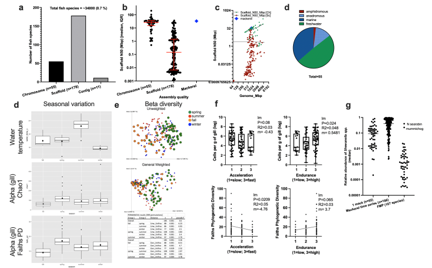COMPARATIVE GENOMICS AND MICROBIOMES OF A HIGH VALUE FISH, PACIFIC CHUB MACKEREL Scomber japonicus: A MODEL FOR MARINE FISH AQUACULTURE
Scomber japonicus is an economically important fishery, consistently in the top 10 (by volume and price) globally, and is an emerging aquaculture species in A sia. Considering mackerel has a high omega-3 fatty acid content, is genetically related to tuna, has a similar life history to most marine aquaculture fin fish, and does not grow more than ~40 cm in length, it has great potential as a model marine fish for aquaculture production . Despite an acceleration in high quality genome assemblies across the animal kingdom , there are currently only ~244 fish genomes available (out of ~34,000 species) with only 55 of these achieving high quality chromosomal- level assembly (Fig 1a). We sequenced and assembled a high quality chromosomal-level genome (788 Mbp , scaffold N50 33.19 Mbp, BUSCO 96.9%) using a combination of Oxford Nanopore long reads and Hi-C sequencing (Fig 1b-c) . We compared the mackerel genome (fads and evol1 genes) to other published fish genomes (Fig 1d) to evaluate if there has been adaptation in lipid digestion efficiency or PUFA biosynthesis via Fads and Evol1 genes. Since mackerel can tolerate a wide temperature range (10 -29 o C), we also wanted to understand if local adaptation and subsequent divergence is occurring in mackerel populations in the Eastern Pacific. We compared full genomes of 22 mackerel across four seasons a year for three years for a total of 12 time points. We also evaluated the extent to which the microbiome varied seasonally by sampling at least four fish per month for three years from a fixed location (Scripps Institution of Oceanography Pier, La Jolla, CA) . The microbiome (alpha diversity and beta) of the gill surprisingly varied most between spring (high diversity) and fall (low diversity) (Figure 1d-e ). Lastly, we compared the gill microbial communities of mackerel to 101 local fish species, representing ~25% of the marine fish diversity in Southern California. Gill microbial biomass and diversity was negatively associated with swimming acceleration speed and positively associated with endurance i n fish suggesting a potential trade off to fast swimming predatory fish (Figure 1f). Compared to the other 101 species, mackerel had much higher RA of the Shewanella.
